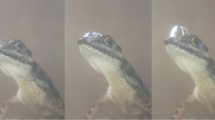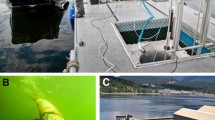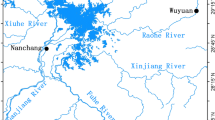Abstract
In aquatic vertebrates that acquire oxygen aerially dive duration scales positively with body mass, i.e. larger animals can dive for longer periods, however in bimodally respiring animals the relationship between dive duration and body mass is unclear. In this study we investigated the relationships between body size, aquatic respiration, and dive duration in the bimodally respiring turtle, Elseya albagula. Under normoxic conditions, dive duration was found to be independent of body mass. The dive durations of smaller turtles were equivalent to that of larger individuals despite their relatively smaller oxygen stores and higher mass specific metabolic rates. Smaller turtles were able to increase their dive duration through the use of aquatic respiration. Smaller turtles had a relatively higher cloacal bursae surface area than larger turtles, which allowed them to extract a relatively larger amount of oxygen from the water. By removing the ability to respire aquatically (hypoxic conditions), the dive duration of the smaller turtles significantly decreased restoring the normal positive relationship between body size and dive duration that is seen in other air-breathing vertebrates.






Similar content being viewed by others
Abbreviations
- β:
-
Oxygen coefficient of capacitance
- ΔDO2 :
-
Change in dissolved O2
- Mb:
-
Body mass
- MR:
-
Metabolic rate
- P50 :
-
PO2 when haemoglobin is 50% saturated with oxygen
- PO2 :
-
Partial pressure of oxygen
- SAm:
-
Mass-specific surface area
- SAt:
-
Total surface area
- t :
-
Length of trial
- VH2O:
-
Volume of water
- VO2 :
-
Oxygen consumption rate
References
Bagatto B, Henry RP (1999) Exercise and forced submergence in the pond slider (Trachemys scripta) and softshell turtle (Apalone ferox): influence on bimodal gas exchange, diving behaviour and blood acid–base status. J Exp Biol 202: 267–278
Bagatto B, Guyer C, Hauge B, Henry RP (1997) Bimodel respiration in two species of Central American turtles. Copeia 1997:834–839
Belkin DA (1968) Aquatic respiration and underwater survival of two freshwater turtle species. Respir Physiol 4:1–14
Benedict FG (1932) The physiology of large reptiles. Carnegie Institution of Washington Publication 425
Bennett AF, Dawson WR (1976) Metabolism. In: Gans C, Dawson WR (Eds) Biology of the reptilia 5. Academic, New York, pp 127–211
Boyd IL (1997) The behavioural and physiological ecology of diving. Trends Ecol Evol 12:213–217
Burggren W, Hahn CEW, Foex P (1977) Properties of blood oxygen transport in the turtle Pseudemys scripta and the tortoise Testudp graeca: effects of temperature, CO2 and pH. Respir Physiol 31:39–50
Burggren W, Smits A, Evans B (1989) Arterial O2 homeostasis during diving in the turtle Chelodina longicollis. Physiol Zool 62:668–686
Butler PJ, Jones DR (1982) The comparative physiology of diving in vertebrates. Lowenstein O (Ed) Advances in comparative physiology and biochemistry. Academic, New York, pp 179–364
Cann J (1998) Australian freshwater turtles. Beaumont Publishing Pvt. Ltd, Singapore
Dejours P (1994) Environmental-factors as determinants in bimodal breathing—an introductory overview. Am Zool 34:178–183
Gordos M, Franklin CE (2002) Diving behaviour of two Australian bimodally respiring turtles, Rheodytes leukops and Emydura macquarii, in a natural setting. J Zool (Lond) 258:335–342
Gordos MA, Franklin CE, Limpus CJ, Wilson G (2004) Blood-respiratory and acid-base changes during extended diving in the bimodally respiring freshwater turtle Rheodytes leukops. J Comp Physiol B Biochem Syst Environ Physiol 174:347–354
Graham JB (1994) An evolutionary perspective for bimodal respiration: a biological synthesis of fish air breathing. Am Zool 34:229–237
Hutton KE, Boyer DR, Williams JC, Campbell PM (1960) Effects of temperature and body size upon heart rate and oxygen consumption in turtles. J Cell Comp Physiol 55:87–93
Irvine LG, Hindell MA, Van Den Hoff J, Burton HR (2000) The influence of body size on dive duration of underyearling southern elephant seals (Mirounga leonina). J Zool (Lond) 251:463–471
King P, Heatwole H (1994) Non-pulmonary respiratory surfaces of the chelid turtle Elseya latisternum. Herpetologica 50:262–265
Kleiber M (1961) The fire of life. An introduction to animal energetics. Wiley, New York
Kooyman GL (1989) Diverse divers. Springer, London
Kooyman GL, Ponganis PJ (1998) The physiological basis of diving to depth: birds and mammals. Annu Rev Physiol 60:19–32
Kramer DL (1988) The behavioral ecology of air breathing by aquatic animals. Can J Zool-Revue Can Zool 66:89–94
Limpus CJ, Limpus DJ, Hamann M (2002) Freshwater turtle populations in the area to be flooded by the walla weir, Burnett river, Queensland: baseline study. Mem Queensl Mus 48:155–168
Maginniss LA, Tapper SS, Miller LS (1983) Effects of chronic cold and submergence on blood oxygen transport in the turtle Chrysemys picta. Respir Physiol 53:15–29
Maina JN (2002) Structure, function and evolution of the gas exchangers: comparative perspectives. J Anat 201:281–304
Priest TE, Franklin CE (2002) Effect of water temperature and oxygen levels on the diving behavior of two freshwater turtles: Rheodytes leukops and Emydura macquarii. J Herpetol 36:555–561
Schmidt-Nielsen K (1970) Energy metabolism, body size, and problems of scaling. Fed Proc 29:1524–1532
Schmidt-Nielsen K (1984) Scaling, why is animal size so inmporant?. Cambridge University Press, Melbourne
Schreer JF, Kovacs KM (1997) Allometry of diving capacity in air-breathing vertebrates. Can J Zool 75:339–358
Stone PA, Dobie JL, Henry RP (1992) Cutaneous surface-area and bimodal respiration in soft-shelled (Trionyx-spiniferus), stinkpot (Sternotherus-odoratus), and mud turtles (Kinosternon-subrubrum). Physiol Zool 65:311–330
Thomson S, Georges A, Limpus CJ (2006) A new species of freshwater turtle in the genus Elseya (Testudines: Chelidae) from central coastal Queensland, Australian. Chelonian Conserv Biol 4 (in press)
Withers PC (1977) Measurement of VO2, VCO2, and evaporative water-loss with a flow-through mask. J Appl Physiol 42:120–123
Acknowledgments
We would like to thank Queensland Parks and Wildlife Service for help with turtle collection and husbandry advice. Turtle collection and experimentation was approved by Queensland Parks and Wildlife Service (SPP—WISP01477903) and supported by The University of Queensland Ethics Committee (AEC—ZOO/ENT/595/04/URG. This research was funded by a University of Queensland Research Grant to CEF.
Author information
Authors and Affiliations
Corresponding author
Additional information
Communicated by I.D. Hume
Rights and permissions
About this article
Cite this article
Mathie, N.J., Franklin, C.E. The influence of body size on the diving behaviour and physiology of the bimodally respiring turtle, Elseya albagula . J Comp Physiol B 176, 739–747 (2006). https://doi.org/10.1007/s00360-006-0095-6
Received:
Revised:
Accepted:
Published:
Issue Date:
DOI: https://doi.org/10.1007/s00360-006-0095-6




